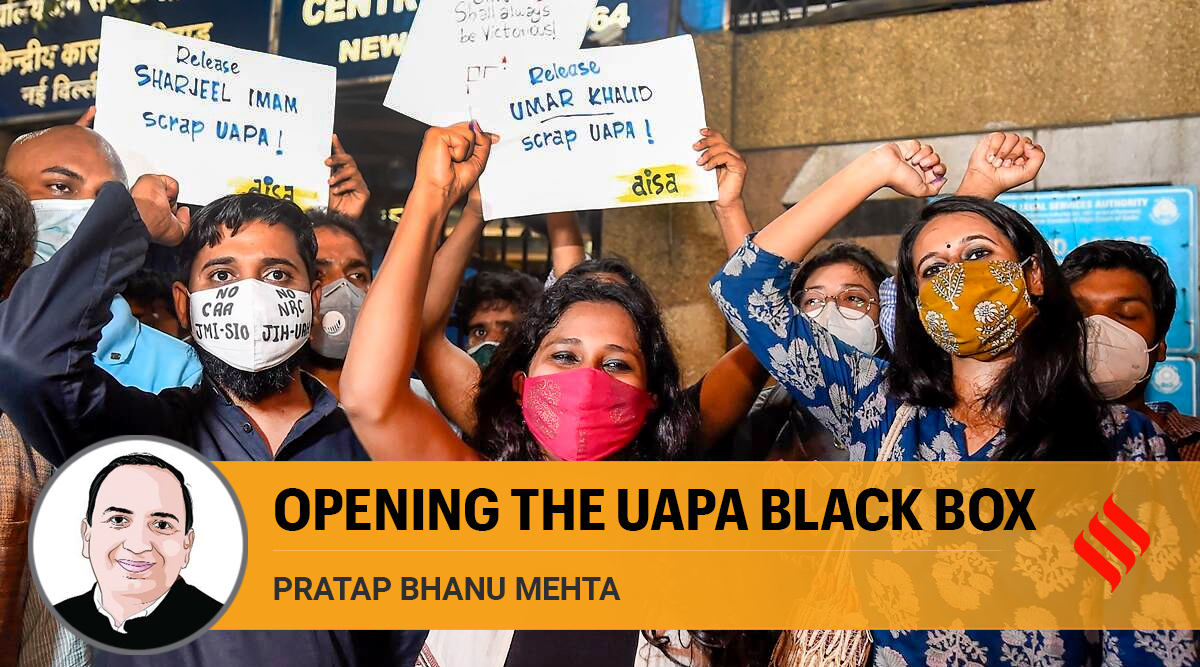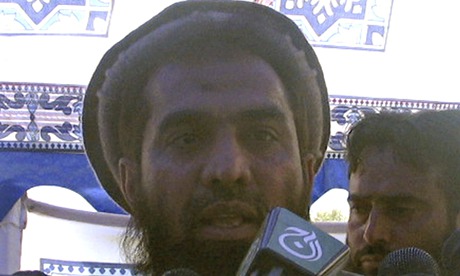'People will forgive you for being wrong, but they will never forgive you for being right - especially if events prove you right while proving them wrong.' Thomas Sowell
Search This Blog
Showing posts with label bail. Show all posts
Showing posts with label bail. Show all posts
Friday, 29 July 2022
Thursday, 12 May 2022
Sunday, 19 December 2021
Monday, 25 October 2021
Sunday, 8 August 2021
Sunday, 18 July 2021
Wednesday, 14 July 2021
Sunday, 11 July 2021
Friday, 18 June 2021
Has the blackbox of UAPA finally been opened?
Pratap Bhanu Mehta in The Indian Express


Student activists Natasha Narwal, Devangana Kalita and Asif Iqbal Tanha outside Tihar prison, after a court ordered their immediate release in the north-east Delhi riots "conspiracy" case, in New Delhi, Thursday, June 17, 2021. (PTI Photo)
The orders passed by Justices Siddharth Mridul and Anup J Bhambhani, granting bail to Asif Tanha, Devangana Kalita, and Natasha Narwal, have opened up the black box of the UAPA (Unlawful Activities Prevention Act) jurisprudence. The UAPA had become the black box of Indian jurisprudence for a number of reasons. First, as the orders note, the definition of “terrorism” in Section 15 of the UAPA is vague, and has been used as a licence to classify all kinds of infractions as terrorist. This order will put more spotlight on how individuals are charged under the provisions of the UAPA.
It requires that the state show why the alleged crimes or infractions should not be dealt with by laws dealing with conventional offences under the IPC or other relevant laws. It also helpfully points out that a simple law-and-order problem in a state should not be equated with a terrorist problem. By making a clear distinction that the former is a state subject, and the latter a Union subject under lists one and two, the order, potentially, also has implications for federalism in matters of law enforcement.
Second, it lays down at least a general standard for when a case might be made for being charged under the UAPA. In particular, this order insists that the allegations made against the accused must be backed up by facts, must pertain to acts undertaken by them as individuals, and must be specifically framed. This goes counter to the recent trend where sometimes chargesheets rely as much on speculation as fact, invoke circumstantial considerations about the broad political context rather than acts committed by individuals, and are framed vaguely.
Third, this order opens up the important issue of bail. The UAPA, broadly interpreted, can be a Kafkaesque law when it comes to bail. It prohibits granting bail if there are reasonable grounds for believing that the prosecution’s case might be prima facie true. The problem with this is that often the prosecution’s version was accepted without serious cross-examination. But the Supreme Court had put the defendants in an even more Catch-22 situation, by effectively prohibiting courts from engaging in a substantial examination of the merits of a case during the bail hearings. This order reiterates the fact that courts still have a lot of room to subject the government’s case to scrutiny even in bail hearings. They can examine, as this order has done, how the law has been applied, and they can even look into evidentiary questions. There is a little bit of a conceptual challenge here, though. The court rightly looked into the nature of the evidence presented by the state in this case, and effectively demolished it. Based on the considerations put forward in these orders, it is difficult to imagine another court being able to uphold the state’s case for prosecution.
The question is, if a higher court hears a bail hearing, how can its orders be crafted in a way that does not prejudge the outcome of a full-blown trial. In this case, the charges and evidence were patently absurd. It is difficult to see how the court could have come to any other conclusion. But when higher courts hear bail hearings and grant relief based on the demolition of the prosecution’s case, what implications does it have for a full trial? This case gives a good prudential reason for the state not to oppose bail in many circumstances precisely for this reason: Opposing bail opens up the case to greater scrutiny without the context of a full trial. This is an interesting conceptual issue.
This order is also a welcome effort to prevent our civil liberties from being swallowed up by the black hole of state power. The UAPA is also a problematic law because it attacks the presumption of innocence. The Supreme Court is becoming wobbly on as fundamental a right as habeas corpus, the state is construing the expression of thought as a crime, ordinary protest is being suppressed or criminalised, bail is being routinely denied, and the state is actively targeting dissenters. In this context, the reiteration of some common sense principles is very welcome: It provides some relief and hope for constitutional wisdom to prevail. Hopefully, it will empower more judges to do their duty.
The orders passed by Justices Siddharth Mridul and Anup J Bhambhani, granting bail to Asif Tanha, Devangana Kalita, and Natasha Narwal, have opened up the black box of the UAPA (Unlawful Activities Prevention Act) jurisprudence. The UAPA had become the black box of Indian jurisprudence for a number of reasons. First, as the orders note, the definition of “terrorism” in Section 15 of the UAPA is vague, and has been used as a licence to classify all kinds of infractions as terrorist. This order will put more spotlight on how individuals are charged under the provisions of the UAPA.
It requires that the state show why the alleged crimes or infractions should not be dealt with by laws dealing with conventional offences under the IPC or other relevant laws. It also helpfully points out that a simple law-and-order problem in a state should not be equated with a terrorist problem. By making a clear distinction that the former is a state subject, and the latter a Union subject under lists one and two, the order, potentially, also has implications for federalism in matters of law enforcement.
Second, it lays down at least a general standard for when a case might be made for being charged under the UAPA. In particular, this order insists that the allegations made against the accused must be backed up by facts, must pertain to acts undertaken by them as individuals, and must be specifically framed. This goes counter to the recent trend where sometimes chargesheets rely as much on speculation as fact, invoke circumstantial considerations about the broad political context rather than acts committed by individuals, and are framed vaguely.
Third, this order opens up the important issue of bail. The UAPA, broadly interpreted, can be a Kafkaesque law when it comes to bail. It prohibits granting bail if there are reasonable grounds for believing that the prosecution’s case might be prima facie true. The problem with this is that often the prosecution’s version was accepted without serious cross-examination. But the Supreme Court had put the defendants in an even more Catch-22 situation, by effectively prohibiting courts from engaging in a substantial examination of the merits of a case during the bail hearings. This order reiterates the fact that courts still have a lot of room to subject the government’s case to scrutiny even in bail hearings. They can examine, as this order has done, how the law has been applied, and they can even look into evidentiary questions. There is a little bit of a conceptual challenge here, though. The court rightly looked into the nature of the evidence presented by the state in this case, and effectively demolished it. Based on the considerations put forward in these orders, it is difficult to imagine another court being able to uphold the state’s case for prosecution.
The question is, if a higher court hears a bail hearing, how can its orders be crafted in a way that does not prejudge the outcome of a full-blown trial. In this case, the charges and evidence were patently absurd. It is difficult to see how the court could have come to any other conclusion. But when higher courts hear bail hearings and grant relief based on the demolition of the prosecution’s case, what implications does it have for a full trial? This case gives a good prudential reason for the state not to oppose bail in many circumstances precisely for this reason: Opposing bail opens up the case to greater scrutiny without the context of a full trial. This is an interesting conceptual issue.
This order is also a welcome effort to prevent our civil liberties from being swallowed up by the black hole of state power. The UAPA is also a problematic law because it attacks the presumption of innocence. The Supreme Court is becoming wobbly on as fundamental a right as habeas corpus, the state is construing the expression of thought as a crime, ordinary protest is being suppressed or criminalised, bail is being routinely denied, and the state is actively targeting dissenters. In this context, the reiteration of some common sense principles is very welcome: It provides some relief and hope for constitutional wisdom to prevail. Hopefully, it will empower more judges to do their duty.
But it is premature to be optimistic about the direction of civil liberties in India. It is a matter of great relief that the trial court has finally released the accused. But prior to that, their release was delayed by a day on the grounds that their address had not been verified. If the state could not verify the address of someone they had in their custody for a year, you don’t know whether to laugh or cry. It is almost as if the authorities decided to enact a parody version of their impunity. But there is no escaping this fact. The order is an indictment of the Delhi Police and its masters in the Ministry of Home Affairs. In any civilised democracy, heads would have rolled. Instead, what we will get is an aggressive appeal by the state. We can only hope the Supreme Court will not let the cause of liberty down again.
We also know that landmark orders often have very little effect on the state or the culture of the judiciary. They sometimes work in high-profile cases. Sometimes they are a reflection of conscientious judges doing their duty as these judges seem to have done. But more often than not, they have been a flash in the pan that allow us to hold on to the illusion that the judiciary will at some point dispense justice. Will this order, by the power of its example, have an implication for the travesty of justice being enacted in the Bhima Koregaon cases, and the fate of Sudha Bharadwaj and Anand Teltumbde? Just yesterday this paper carried the story on the front page of Mohammed Ilyas and Mohammed Irfan, who were acquitted of UAPA-related charges after nine years, seven of which they spent in jail having had four bail applications turned down. It is a reminder that the pathologies of the UAPA are not specific to particular political parties, but were hardwired into the system.
This bail order has opened up the black box of UAPA jurisprudence. It is well reasoned, without histrionics, and full of constitutional common sense. But whether this order will be sufficient to wipe off the recent black marks against the judiciary remains to be seen.
We also know that landmark orders often have very little effect on the state or the culture of the judiciary. They sometimes work in high-profile cases. Sometimes they are a reflection of conscientious judges doing their duty as these judges seem to have done. But more often than not, they have been a flash in the pan that allow us to hold on to the illusion that the judiciary will at some point dispense justice. Will this order, by the power of its example, have an implication for the travesty of justice being enacted in the Bhima Koregaon cases, and the fate of Sudha Bharadwaj and Anand Teltumbde? Just yesterday this paper carried the story on the front page of Mohammed Ilyas and Mohammed Irfan, who were acquitted of UAPA-related charges after nine years, seven of which they spent in jail having had four bail applications turned down. It is a reminder that the pathologies of the UAPA are not specific to particular political parties, but were hardwired into the system.
This bail order has opened up the black box of UAPA jurisprudence. It is well reasoned, without histrionics, and full of constitutional common sense. But whether this order will be sufficient to wipe off the recent black marks against the judiciary remains to be seen.
Saturday, 27 February 2021
Friday, 19 December 2014
Yes, Pakistanis are united against terrorism. But not on terrorists
Militants who target India will always be good Taliban. So an alleged architect of the Mumbai attack can be released two days after Peshawar

On this Pakistan is united: the men who killed 132 children in a Peshawar school are terrorists. On this too Pakistan is – temporarily – united: terrorism must be defeated. After that the trouble begins. With something as seemingly innocuous as who, exactly, is a terrorist. Pakistanis can’t seem to agree.
Neither can the media. A day after the Peshawar carnage, after the Pakistan army had announced that the slaughter in the school had been operationally coordinated by Afghan-based Pakistani militants, an outraged analyst on local TV asked what the world’s response would have been had India been attacked by militants from Pakistan.
India, the analyst claimed indignantly, would be contemplating bombing Pakistan and the Indian army would already have been mobilised on the Pak-India border. The world at large, the analyst continued, would have pounced on Pakistan for its terrible behaviour. But, the analyst lamented, because Pakistan is weak, it could do no more than send its army chief to Afghanistan and politely seek the Afghan government’s cooperation.
For many in Pakistan, the analyst’s anger would have resonated. His fulminations against the international community’s perceived discrimination against Pakistan would have garnered much sympathy. To much of the outside world, the analyst’s comparison would have triggered incredulity.
For exactly that scenario – Pakistanis slipping into India to mercilessly kill civilians in a major city – had infamously already occurred. In Mumbai. In 2008. Had the TV analyst simply forgotten? Surely not.
But there the analyst was, on one of Pakistan’s most popular news channels, suggesting that the world does not share Pakistan’s pain. Unsaid, though not uncommunicated, was a darker theory: Pakistan is a victim of an international conspiracy, an innocent victim of geopolitics, alone and vulnerable in a Hobbesian world full of militant proxies.
Ultimately, Pakistan’s problem with militancy is not denial. It is not even ignorance. It is something quite different. Simply, it is the widespread belief that militants fighting the Indian state, militants fighting to free “Indian-held Kashmir”, militants fighting the Afghan government and militants fighting to “free” Afghanistan are not militants. They are the good guys. The righteous ones brave enough to take on the world in the name of the one true God.
The problem was never denial. The problem is the paradigm. The Afghan Taliban are not militants. Lashkar-e-Taiba – LeT –are not terrorists. And, even more insidiously, there are those within Pakistan who do not believe that Tehrik-i-Taliban Pakistan is in the wrong.
Instead, the belief is that the Pakistani state itself is on the wrong path. A democratic path. A path that keeps it in thrall to American, godless, anti-Islam interests. A path that takes Pakistan far from that of the religion in the name of which it was ostensibly created.
That’s really why it’s possible for Pakistan to stun the outside world – two days after the horror of Peshawar – by granting bail to one of the alleged architects of the Mumbai attack, Zaki-ur-Rehman Lakhvi of the officially banned LeT. That’s why it’s possible for Pakistan to confound the world by rejecting global sympathy over the Peshawar attack and embracing LeT instead.
The Lakhvi bail is not a surprise. In truth, it is the inexorable outcome of recent events in Pakistan. Consider just what happened in Lahore, the provincial capital of Punjab and the heart of political power in Pakistan, on 4 December.
Imran Khan, the leader of Pakistan Tehreek-e-Insaf (PTI), had been trying to oust the government of Nawaz Sharif via street protests since August, and threatened to shut down Lahore that day. But within hours of Khan’s announcement on 30 November, the PTI appeared to realise it had made a mistake: the Jamaat-ud-Dawa, a hardline Islamist organisation, was holding its annual congress in Lahore on 4 and 5 December. And so the PTI quickly postponed its protest.
Pause on that for a moment. The business of toppling a national, elected government had to take a back seat to the annual Lahore pilgrimage of Hafiz Saeed, the chief of Jamaat-ud-Dawa. It was perhaps inevitable. With the Narendra Modi government in India taking a hawkish line on Pakistan, pro-Kashmir, anti-India jihadis in Pakistan were always going to take centre stage.
There is though at least one thing that Pakistan remains wilfully blind to. Every single one of the militant groups fighting the Pakistani state today was once at some point in recent history considered to be a good militant/good Taliban. Just like Hafiz Saeed is today.
Subscribe to:
Comments (Atom)
